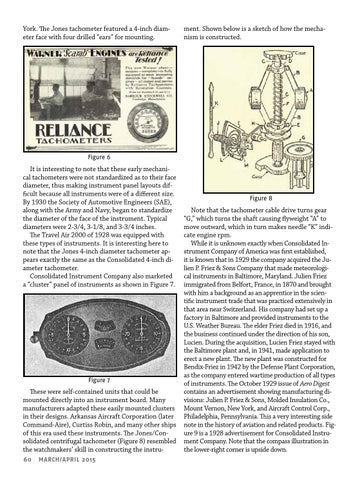York. The Jones tachometer featured a 4-inch diameter face with four drilled “ears” for mounting.
ment. Shown below is a sketch of how the mechanism is constructed.
Figure 6
It is interesting to note that these early mechanical tachometers were not standardized as to their face diameter, thus making instrument panel layouts difficult because all instruments were of a different size. By 1930 the Society of Automotive Engineers (SAE), along with the Army and Navy, began to standardize the diameter of the face of the instrument. Typical diameters were 2-3/4, 3-1/8, and 3-3/4 inches. The Travel Air 2000 of 1928 was equipped with these types of instruments. It is interesting here to note that the Jones 4-inch diameter tachometer appears exactly the same as the Consolidated 4-inch diameter tachometer. Consolidated Instrument Company also marketed a “cluster” panel of instruments as shown in Figure 7.
Figure 7
These were self-contained units that could be mounted directly into an instrument board. Many manufacturers adapted these easily mounted clusters in their designs. Arkansas Aircraft Corporation (later Command-Aire), Curtiss Robin, and many other ships of this era used these instruments. The Jones/Consolidated centrifugal tachometer (Figure 8) resembled the watchmakers’ skill in constructing the instru60
MARCH/APRIL 2015
Figure 8
Note that the tachometer cable drive turns gear “G,” which turns the shaft causing flyweight “A” to move outward, which in turn makes needle “K” indicate engine rpm. While it is unknown exactly when Consolidated Instrument Company of America was first established, it is known that in 1929 the company acquired the Julien P. Friez & Sons Company that made meteorological instruments in Baltimore, Maryland. Julien Friez immigrated from Belfort, France, in 1870 and brought with him a background as an apprentice in the scientific instrument trade that was practiced extensively in that area near Switzerland. His company had set up a factory in Baltimore and provided instruments to the U.S. Weather Bureau. The elder Friez died in 1916, and the business continued under the direction of his son, Lucien. During the acquisition, Lucien Friez stayed with the Baltimore plant and, in 1941, made application to erect a new plant. The new plant was constructed for Bendix-Friez in 1942 by the Defense Plant Corporation, as the company entered wartime production of all types of instruments. The October 1929 issue of Aero Digest contains an advertisement showing manufacturing divisions: Julien P. Friez & Sons, Molded Insulation Co., Mount Vernon, New York, and Aircraft Control Corp., Philadelphia, Pennsylvania. This a very interesting side note in the history of aviation and related products. Figure 9 is a 1928 advertisement for Consolidated Instrument Company. Note that the compass illustration in the lower-right corner is upside down.
